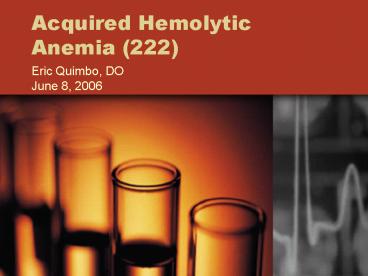Acquired Hemolytic Anemia (222) - PowerPoint PPT Presentation
1 / 16
Title:
Acquired Hemolytic Anemia (222)
Description:
... Hemolytic Uremic Syndrome Clinical Findings TTP Adults Neuro effects HUS Children Renal system impairment Thrombotic Thrombocytopenic Purpura (TTP) ... – PowerPoint PPT presentation
Number of Views:516
Avg rating:3.0/5.0
Title: Acquired Hemolytic Anemia (222)
1
Acquired Hemolytic Anemia (222)
- Eric Quimbo, DO
- June 8, 2006
2
Introduction
- Destruction of red blood cells (RBCs) not due to
genetic or congential disorder - Varying disease severity
- Asymptomatic to fatal hemolysis
- Can be isolated or part of a large clinical
syndrome
3
Presentation
- Weakness
- Dizziness
- DOE
- Tachycardia
- Murmur
- Abdominal pain
- Pallor
- Jaundice
- Fever, lymphadenopathy
- systemic disease
- Splenomegaly
- Chronic
- Hepatomegaly
- Darkened urine
- Intravascular hemolysis, hemoglobinuria
4
Diagnosis
- Spherocytes/schistocytes on peripheral smear
- ?Hct
- ?Retic count
- ?indirect bilirubin (? Hgb breakdown)
- ?LDH
http//www.wadsworth.org/chemheme/heme/glass/cytop
ix/slide014schisto2.jpg
5
Overview
- Immune-mediated
- Autoimmune
- Alloimmune
- Hemolytic disease of the newborn
- Drug-related
- Microangiopathic
- Thrombotic thrombocytopenic purpura (TTP)
- Hemolytic-uremic syndrome (HUS)
- Pregnancy-related (HELLP)
- Macrovascular
- Prosthetic heart valves
6
Autoimmune Hemolytic Anemia (AIHA)
- Result of generalized immune system dysfunction
- 1-3 cases/100,000 yearly
- Diagnosis
- Positive direct antigen test (DAT) and antibody
identification - Types
- Warm Antibody
- Cold Antibody
7
Autoimmune Hemolytic Anemia (AIHA)
- Warm Antibody (near 37 C)
- 70 AIHA cases
- Chronic lymphocytic leukemia
- Treatment
- First line
- High-dose corticosteroids prednisone PO 1 1.5
mg/kg QD for 1-3 weeks - Splenectomy
- Removes site of hemolysis and of antibody
production - 65 70 response rate
- Should receive pneumococcal and meningiococcal
vaccinations b/c of risk of infection of
encapsulated bacteria - Cytotoxic Drugs
- 40 60 response rate
- Failed steroid and splenectomy treatment
- RBC Transfusion (use the least incompatible)
- Life-threatening anemia
- High-risk cardiac or cerebrovascular
8
More AIHA
- Cold Antibody
- Most hemolytic at 0 4 C, leading to clumping
of RBCs on the smears - Cold Agglutinin Syndrome (CAS)
- Typically mild symptoms
- Hgb 9 12
- Tx avoid cold weather, symptomatic tx
- Paroxysmal Cold Hemoglobinuria (PCH)
- Hemolysis at cold normal temps
- High fever, chills, abdominal pain with cold
weather - Tx keep warm, consider steroids
http//www.meddean.luc.edu/lumen/MedEd/medicine/Rh
eumatology/Hands/Hand9/Hand9.jpeg
9
Even more AIHA
- Alloimmune Hemolytic Anemia
- Hemolytic disease of the newborn (HDN)
- RhD negative mom developing antibodies to RhD
positive fetal RBCs. - Mild anemia to fatal results
- Hydrops fetalis seen in severe HDN
- Treatment
- RhoGAM with any fetomaternal hemorrhage event or
post-delivery - Intrauterine and intravascular fetal transfusion
with plasma exchange and/or IV IG
http//www.yamagiku.co.jp/pathology/image/219/1.jp
g
10
Microangiopathic Syndromes
- Involve platelet aggregation in the microvascular
circulation via mediation of von Willebrand
factor (vWF) leading to thrombocytopenia - Microangiopathic anemia (MAHA) develops as
fragmented RBCs travel through occluded
capillaries - Types
- Thrombotic thrombocytopenic purpura (TTP)
- Hemolytic Uremic Syndrome
www.academic.marist.edu/.../description31.html
11
Clinical Findings
- TTP
- Adults
- Neuro effects
- HUS
- Children
- Renal system impairment
Pallor, jaundice, fatigue, DOE are common in
both. Presentations will overlap, making them
difficult to differentiate.
12
Thrombotic Thrombocytopenic Purpura (TTP)
- Classic Pentad
- Thrombocytopenia
- MAHA
- Fever
- Renal impairment
- Neurologic impairment
- Microthrombi created from the large vWF multimers
occur throughout the systemic circulation - Triggers pregnancy, infection, autoimmune
disorders - Diagnosis PLT lt 20K, schistocytes on smear,
elevated retic count - Treatment
- Plasma exchange
- Corticosteroids
- Splenectomy
- Platelet transfusions should be avoided unless
life-threatening bleeding or ICH - Thrombosis may worsen acutely, leading to renal
failure death
Neurologic impairment
http//dermatlas.med.jhmi.edu/derm/display.cfm?Ima
geID1223608648
13
Hemolytic Uremic Syndrome
- Early childhood (6 mos 4 y/o)
- One of the MC causes of ARF
- Presentation
- ARF
- MAHA
- Fever
- Thrombocytopenia
- Clinical - restless, irritable, petechiae,
purpura and oozing may occur - Often follows bacterial/viral illness
- Microthrombi localized to kidneys
- Treatment
- Mild cases fluid electrolyte correction
- Steroids
- Plasma exchange
http//www.dental.mu.edu/oralpath/lesions/petechia
/petechia2.jpeg
14
HELLP Syndrome
- Complication of preeclampsia
- Hemolysis, elevated liver enzymes, low platelets
- 1/1000 pregnancies
- Microvascular platelet-fibrin thrombi which
initially predominate in the liver and may spread - Decreased serum haptoglobin is most sensitive
marker - Treatment delivery of baby
- Supportive measures if unable to deliver
immedately
15
THE END!
Mustache Day 2005
16
Quiz answers..
- Diagnosis of hemolytic anemia include which of
the following? - Increased retic count
- Which is the most common lymphoproliferative
disorder associated with warm-type AIHA? - Chronic lymphocytic leukemia
- Splenectomized patients should
- Receive pneumococcal vaccinations
- Receive meningiococcal vaccinations
- B C
- Which of the following is TRUE?
- HUS is more specific for renal system than TTP
- Which of the following should be avoided in
treatment of TTP? - Platelet transfusions
- Which of the following is the most sensitive
marker for microangiopathic hemolytic anemia in
the setting of HELLP? - Decreased serum haptoglobin level































